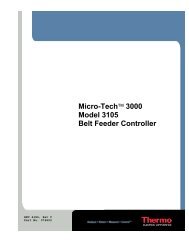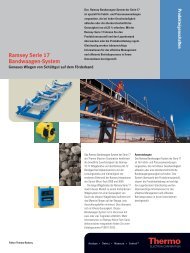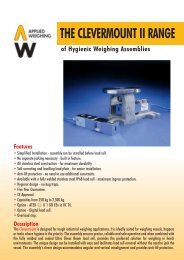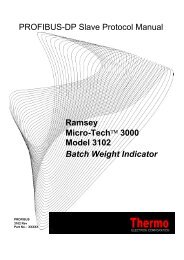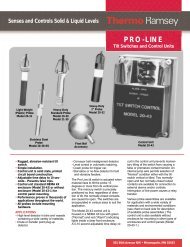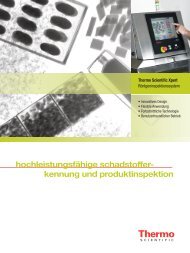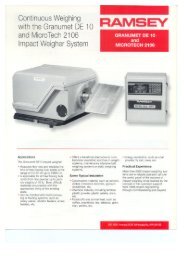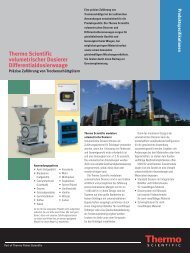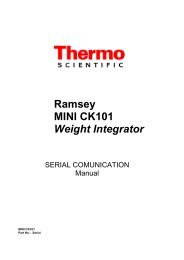Thermo Ramsey - Hoferick Engineering GmbH
Thermo Ramsey - Hoferick Engineering GmbH
Thermo Ramsey - Hoferick Engineering GmbH
Create successful ePaper yourself
Turn your PDF publications into a flip-book with our unique Google optimized e-Paper software.
<strong>Thermo</strong> Fisher Scientific Installation<br />
REC 4175 Rev B<br />
Installation<br />
1.6.3 Print Functions<br />
Periodical and command prints can be obtained by connecting a serial printer to<br />
the Comm output on the motherboard or an optional communication board.<br />
Time and date are permanently stored in the battery-backed memory. The entire<br />
set up of the instrument can also be printed out.<br />
1.6.4 Communication Functions<br />
There are two types of standard communication functions. Each is discussed<br />
below:<br />
• Serial Communications – The communication protocol allows a remote<br />
intelligent device to read the contents of the registers and write to some<br />
registers.<br />
During the communication activity, the Micro-Tech 3101 always acts as a<br />
Slave, meaning it responds to a request from a Master device on the line, but<br />
never attempts to send messages out.<br />
One electrical interface may be selected and accessed through one<br />
communication port. Up to three communicaiotn boards may be installed.<br />
• Field Bus I/O – Allen-Bradley RIO or Profibus-DP I/O, or DeviceNet<br />
communication protocol board is typically used to transfer I/O images<br />
between a main PLC and the remote devices (normally remote I/O racks –<br />
rack adapters) or to transfer (read and write blocks of data with intelligent<br />
remote devices (node adapters), the Micro-Tech 3101 in this case.<br />
The Remote I/O is a typical master/slave communication where the main<br />
PLC is the master or scanner and the remote devices are slaves or adapters.<br />
1.7 Functional Description<br />
This section describes technically, how the Micro-Tech 3101 performs each<br />
particular duty.<br />
1.7.1 Measuring Functions<br />
1.7.1.1 Instantaneous Flow Rate Calculation<br />
The signal measured by the load cell(s), which represents the weight per unit<br />
length of the belt (lbs/ft), is multiplied by the signal measured by the speed<br />
transmitter, which represents the belt speed (ft/mn). The result of this operation<br />
is the instantaneous flow rate (lbs/ft x ft/mn = lbs/mn) that is then multiplied by<br />
suitable constant to obtain the value in the required engineering units (kg/h,<br />
ton/h, etc.). An adjustable damping filter is provided separately for displayed<br />
rate and current outputs.<br />
1.7.1.2 Flow Totalization<br />
The total is accumulated by multiplying weight per unit length times the<br />
incremental length and totalizing the result in engineering units.<br />
Three totalizing memories are provided:<br />
• The first memory (Master Total) is not re-settable to guarantee the data is<br />
not lost because of unwanted reset.<br />
• The second and third memories (Reset and Operator Total) are re-settable<br />
by the operator and normally used for shift or daily Totalization.<br />
1-5




